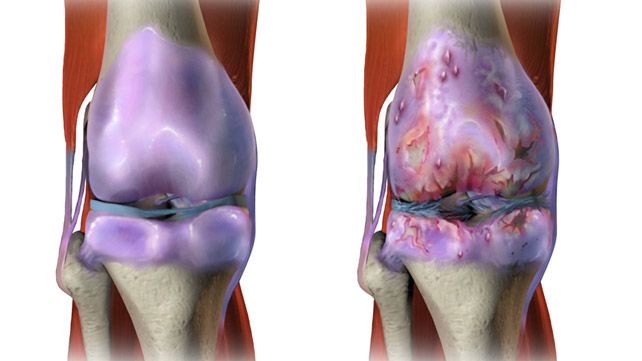Osteoarthritis (OA) is a degenerative and low grade inflammatory joint disease that happens when the cartilage between your bones disintegrates. As it progresses, it can change what your joints look like.
Over time, the cartilage in your joints gradually disintegrates.
Current research has identified tiny fractures and damage to cartilage, causing it to degrade, and also leading to inflammation and swelling. This can cause pain, stiffness, and swelling.
OA most commonly affects the knees, hips, neck, lower back, toes, and hands. In this article, we’ll break down the symptoms of each and show what OA looks like.
The knee is one of the most common joints affected by OA.
You can feel pain all over the knee. It can affect your mobility and restrict your ability to move, which is especially difficult for people who rely on walking a lot during the day.
Some symptoms you may experience include:
- stiffness and swelling
- difficulty bending your knee
- more pain or swelling in the morning or after resting
- locking, creaking, clicking, snapping, or grinding
- feeling like your knee is weak or buckling
- increased pain after physical activity or wet weather
People with hip OA have pain around the hip joint that gets worse over time. As time goes on, the pain can become more frequent and more severe. You may also experience more pain at night or when you’ve been resting.
Other symptoms of hip OA include:
- pain in the groin or thigh that radiates out to the buttocks or knee
- stiffness in the morning or after resting or standing
- pain after physical activity
- stiffness in the joint, or difficulty walking and bending
- sticking, locking, or grinding of the hip joint
- decreased range of motion
- increased pain during wet weather
Learn more about treatment options for hip arthritis.
Neck OA can cause stiffness and pain in the neck.
Some symptoms you may experience include:
- pain when holding the neck in the same position for long periods of time
- headaches
- grinding sensation or popping noise when turning the neck
- numbness or weakness in hands, fingers, and arms
- difficulty with balance
- feeling weakness in the hands and legs
- difficulty walking
- muscle spasms in the shoulders and neck
Learn more about neck exercises for arthritis.
Back OA causes pain in the spine or lower back.
Some symptoms you may experience include:
- back pain deep in the muscles
- increased pain when sitting or standing upright, and reduced pain while lying down
- lower back pain that is worse in the morning or after periods of inactivity
- stiffness and limited motion in the spine
For the most part, pain and stiffness will develop over time in the joint areas of the toe. This can affect your mobility.
Some symptoms of toe OA include:
- pain when moving the toe
- pain that gets worse after physical activity
- difficulty walking
- tenderness, swelling, warmth, or redness on the joint
- decreased range of motion
The hand and wrist include many small joints that work together to generate motion. When those joints are impaired, it can lead to pain and uncomfortable symptoms, as well as reduced or limited mobility in your hands.
Symptoms of hand OA include:
- dull or burning sensation in the hand
- increased pain after long periods of repetitive usage
- pain in the morning
- stiffness, swelling, or enlargement of the joint
- cysts
- feelings of grinding between joints
Learn more about hand exercises to ease arthritis pain.
OA can cause pain and reduced mobility, but many treatments are available. Work with your doctor to develop a treatment plan, and let them know if you have increased pain.
Because OA is a degenerative disease, meaning it gets worse over time, you may need to adjust your treatment plan as the condition progresses.

